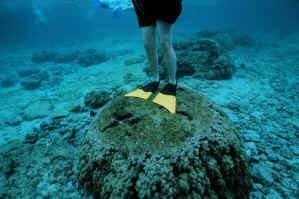|
DIVER
Impacts
on
coral reefS at Kealakekua BaY, Hawai’i
Introduction
 Coral
reefs are diverse and productive biological communities and important natural
resources in tropical areas. However, reefs in many parts of the world are
currently being threatened with a wide variety of anthropogenic disturbances
(Richmond, 1993). In the state of Hawai’i, coral reef resources are worth over
$100 billion and are being degraded by overfishing, sediment runoff, nutrient
pollution, and impacts from tourism (Clark and Gulko, 1999). On the island of
Hawai’i, tourism
along the west coast of the island is focused largely on nearshore
activities, especially sunbathing, beachcombing, snorkeling and diving. In a
typical year thousands of visitors swim, snorkel and dive over the reefs to
observe corals, other invertebrates and colorful fishes. As the number of
visitors has increased in recent years there has been an increasing concern
about potential impacts to coral reef ecosystems. In particular, observations of
swimmers, snorkelers and divers standing and sitting on the coral are common as
are instances of divers fins' breaking coral. Increasing occurrences of both
bleached and broken coral in areas frequently visited by divers raised concern
by the Hawai'i Division of Aquatic Resources that prompted the initiation of
this study. Coral
reefs are diverse and productive biological communities and important natural
resources in tropical areas. However, reefs in many parts of the world are
currently being threatened with a wide variety of anthropogenic disturbances
(Richmond, 1993). In the state of Hawai’i, coral reef resources are worth over
$100 billion and are being degraded by overfishing, sediment runoff, nutrient
pollution, and impacts from tourism (Clark and Gulko, 1999). On the island of
Hawai’i, tourism
along the west coast of the island is focused largely on nearshore
activities, especially sunbathing, beachcombing, snorkeling and diving. In a
typical year thousands of visitors swim, snorkel and dive over the reefs to
observe corals, other invertebrates and colorful fishes. As the number of
visitors has increased in recent years there has been an increasing concern
about potential impacts to coral reef ecosystems. In particular, observations of
swimmers, snorkelers and divers standing and sitting on the coral are common as
are instances of divers fins' breaking coral. Increasing occurrences of both
bleached and broken coral in areas frequently visited by divers raised concern
by the Hawai'i Division of Aquatic Resources that prompted the initiation of
this study.
The goal of this study was to estimate
the extent of damage due to divers using the incidence of bleached and broken
coral at a popular tourist site, Kealakekua
Bay, in west Hawai'i. The study
compared the incidence of bleached and broken coral in an area of high diver
activity to those in an adjacent low diver activity area. This study thus
assumes that the two study areas were similar prior to the beginning of the
study and had similar natural rates of bleaching and coral damage during the
study period. These assumptions were tested during the course of the study.
| Home
| Introduction | Methods | Results
| Discussion | Data | Acknowledgements
|
|
